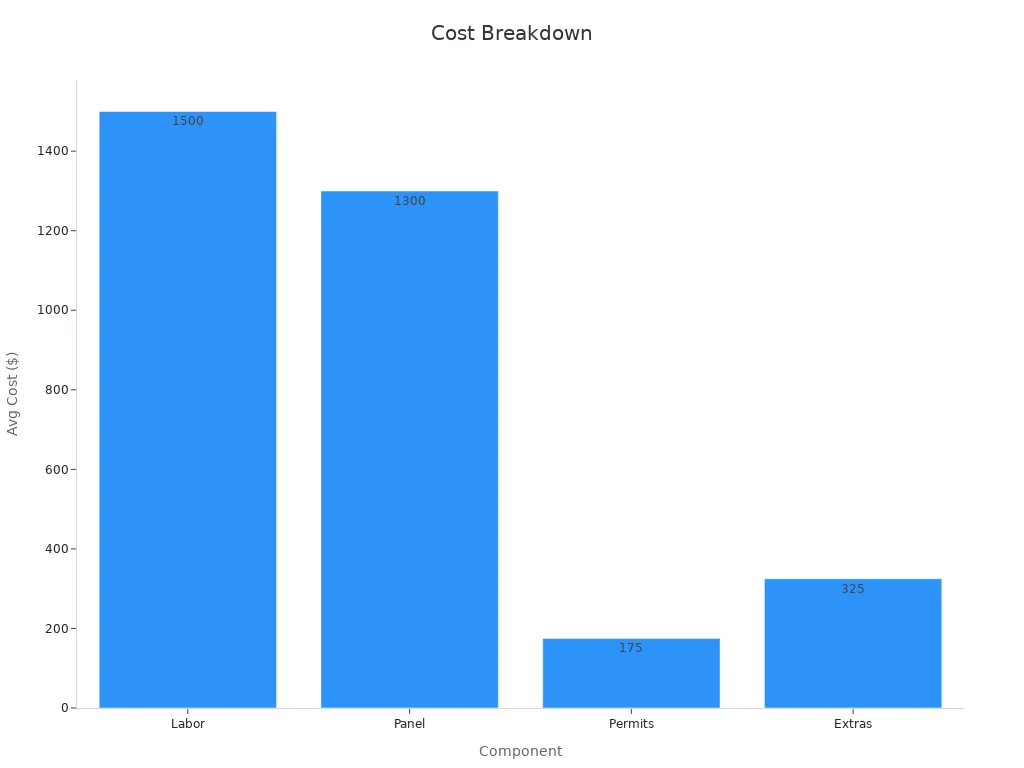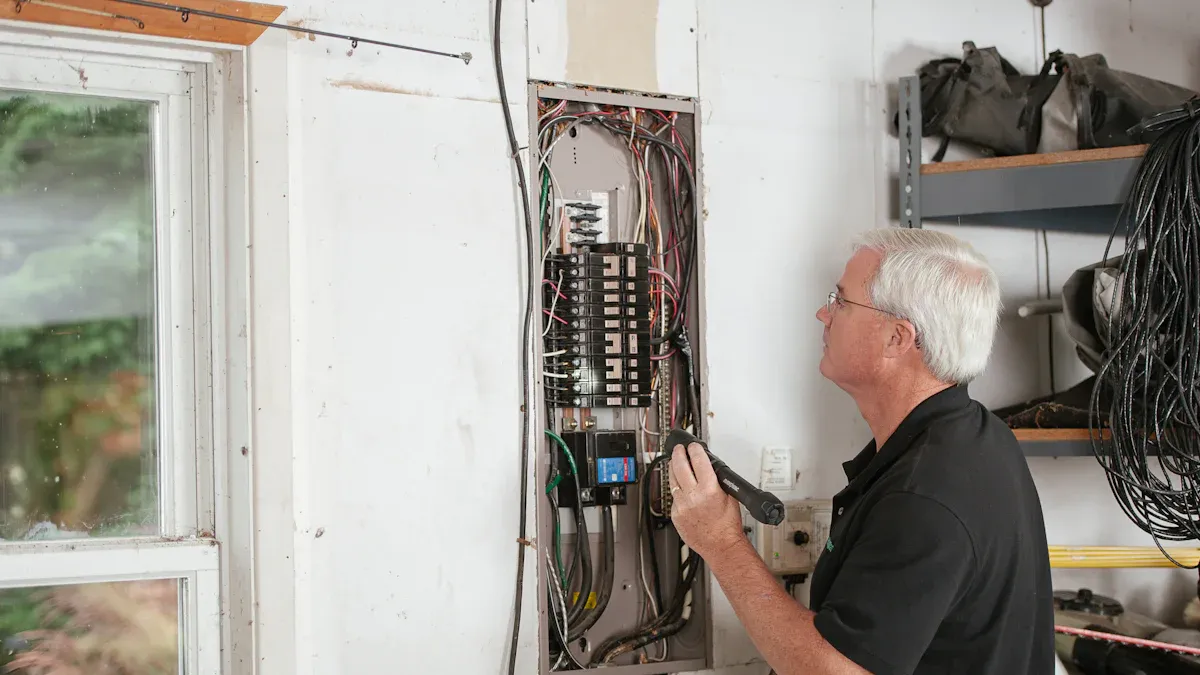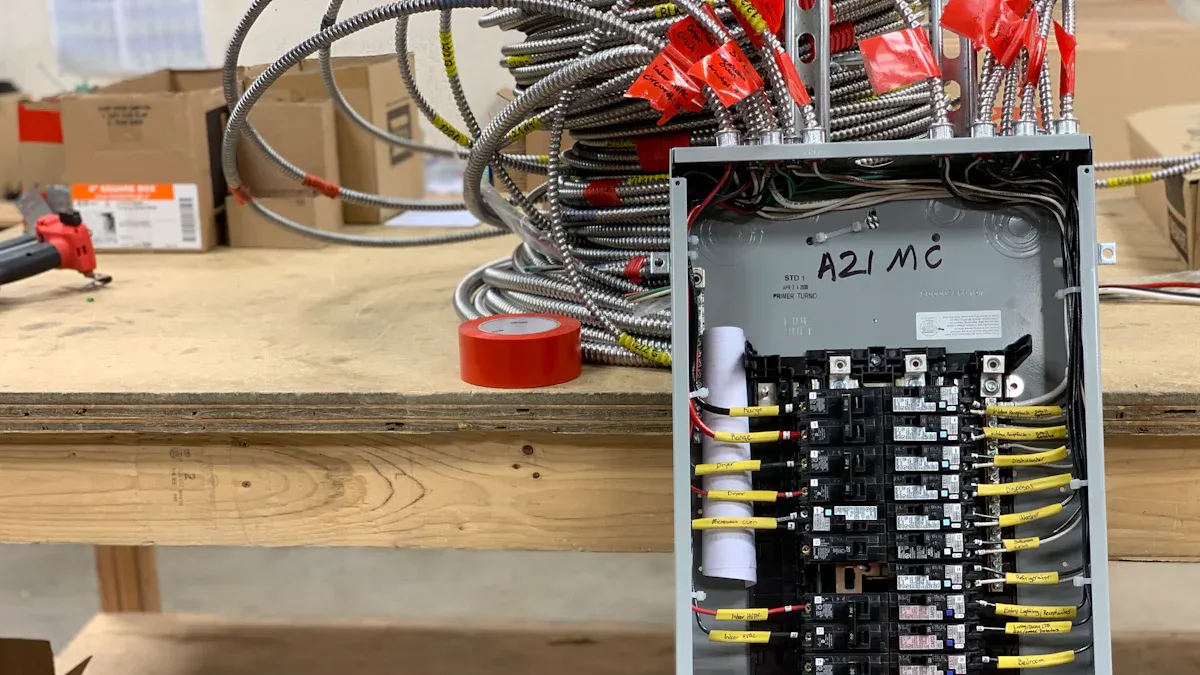Replacing a 100 ampere circuit breaker panel usually costs between $800 and $1,500, with most homeowners spending around $1,313. You need to know these costs because safety, home upgrades, and insurance often depend on having a modern, reliable panel. Prices can change based on labor, panel type, and extra parts. Planning ahead helps you avoid surprises and choose the right panel for your needs.
Key Takeaways
- Replacing a 100 ampere circuit breaker panel usually costs between $850 and $1,600, but extra work can raise the price.
- Labor, permits, panel type, and additional wiring are the main factors that affect the total replacement cost.
- Watch for warning signs like flickering lights, burning smells, or warm spots on the panel to know when to replace it.
- Follow a clear replacement process that includes safety checks, permits, labeling wires, and inspections to ensure proper installation.
- Always hire a licensed electrician to meet legal rules, ensure safety, and avoid costly mistakes or fines.
Cost Overview
Average Cost
You can expect to pay between $1,300 and $1,600 for a typical 100 ampere circuit breaker panel replacement. Some projects cost as little as $850 for basic jobs, while complex replacements can reach up to $4,000. The price depends on the type of panel, the amount of labor needed, and any extra work required. Most homeowners see costs in the $1,200 to $2,500 range for standard replacements. If your home needs extra electrical work or upgrades, the total can rise to $2,500–$5,000.
Recent market data shows that labor costs do not change much based on the amperage of the panel. Upgrading to a higher amperage panel during replacement usually adds only $50 to $100 more. Most homes use panels between 60 and 400 amps, but the 100 ampere circuit breaker panel remains common in older or smaller homes.
Note: The cost to replace just the main breaker switch is much lower than replacing the full panel. A main breaker switch swap may cost only a few hundred dollars, while a full panel replacement includes new wiring, permits, and more labor.
Cost Breakdown
You will see several parts in the total cost for a 100 ampere circuit breaker panel replacement. The main components are the panel itself, labor, permits, and any extras like wiring or repairs. Labor is usually the largest part of the bill.
Here is a simple table to help you understand the breakdown:
| Component | Cost Range / Average |
|---|---|
| Electrician Labor | $40–$250 per hour; 4–8 hours; average $1,500 |
| Panel Replacement | $520–$2,200; average around $1,300 |
| Permits | $50–$300, often included by electrician |
| Additional Materials | Under $50 (wiring, connectors, fittings) |
| Extra Wiring (if needed) | Around $300 extra |

Panel brands can also change the price. For example, a Square D panel costs about $111, while a General Electric panel can cost $1,180. Choosing a more expensive brand will raise your total cost.
The size and type of the panel matter too. Small panels with 16 circuits cost $180–$200, while larger panels with 40 or more circuits can cost up to $300. The type of breakers you need also affects the price. Standard breakers cost $7–$9 each, but special breakers like AFCI or GFCI can cost $60–$70 each.
Tip: If your panel needs to be moved or if you need new wiring, expect to pay more. New wiring can add $600–$2,300 to your total.
Historical trends show that most panels last about 15 years. Many homeowners replace panels due to age, new technology, or higher power needs. The market for breaker panels keeps growing as more homes need upgrades.
Factors Affecting Price
When you plan to replace a 100 ampere circuit breaker panel, several factors can change the total price. Knowing these details helps you budget and avoid surprises.
Location
Where you live plays a big role in the final cost. Electricians in different regions charge different rates. In some areas, you might pay $80 per hour for labor, while in busy cities, rates can reach $130 per hour. Local permit and inspection fees also vary. Some cities have higher fees or stricter rules. If your home sits in a place with hard-to-reach wiring or older construction, the job may take longer and cost more.
- Labor rates change by region and demand.
- Urban areas often have higher costs.
- Permit and inspection fees differ by city or county.
- Complex wiring or tough access can increase labor time.
Panel Type
The type of panel you choose affects the price. Some older panels, like Federal Pacific Electric (FPE), Zinsco, or Pushmatic, have known safety problems. Electricians often charge more to replace these because they need extra care and may require more upgrades. Insurance companies sometimes ask you to upgrade these panels for safety. Newer panels, smart panels, or panels with more circuits usually cost more than basic models.
Labor and Permits
Labor makes up a large part of the cost. Electricians charge by the hour, and the total time depends on how complex the job is. Permit fees add to the total. Some jobs need extra inspections to meet modern codes. If your home needs code updates, the electrician may spend more time and use more materials.
| Cost Factor | Description | Cost Range / Details |
|---|---|---|
| Labor Rates | Electricians charge $80–$130 per hour | 8–10 hours for basic replacement |
| Permit Fees | Vary by location and job complexity | $50–$300 |
| Code Compliance | May need extra inspections and upgrades | Adds labor and material costs |
Additional Work
Extra electrical work can raise the price. If you need new wiring, grounding rods, or surge protection, expect to pay more. Upgrading to a larger panel or moving the panel also increases the cost. For example, adding whole-house surge protection can cost $300 to $700. New wiring or meter box upgrades add even more.
- Amperage upgrades increase the price.
- New breakers or special breakers cost more.
- Grounding rods and surge protection add to expenses.
- Service relocations or meter upgrades make the job more complex.
Understanding these factors helps you make smart choices when replacing your 100 ampere circuit breaker panel.
100 Ampere Circuit Breaker Panel: When to Replace

Warning Signs
You should know when your 100 ampere circuit breaker panel needs replacement. Several warning signs can help you spot trouble early. Look for these issues:
- Flickering or dimming lights in your home
- Circuit breakers that trip often or will not reset
- Burning smells or visible scorch marks near the panel
- Buzzing or crackling sounds coming from the panel
- Rust, moisture, or corrosion on or inside the panel
- Warm or hot spots on the panel surface
If you notice any of these problems, your panel may not work safely. Old panels can struggle to handle modern electrical loads. You might also see melted wires or loose connections. These signs mean your panel could fail or even cause a fire. Do not ignore these warnings. Acting quickly keeps your home and family safe.
⚠️ Tip: If your panel feels warm or you smell burning, turn off the main breaker and call a licensed electrician right away.
Safety and Compliance
Safety and compliance matter when you deal with electrical panels. You must follow strict rules to protect your home. The NFPA 70E electrical safety standards require you to de-energize panels before any work. Removing a panel cover while it is still live can cause shock or arc flash injuries. Electricians use special tools like infrared thermal scanners to check for overheating without opening the panel.
Systematic inspections help measure safety and compliance. These checks include:
- Examining the outside and inside of the panel for damage, dirt, or missing labels
- Checking wiring for tightness, correct size, and no signs of overheating
- Making sure breakers fit well and have the right ratings
- Confirming that all labels and directories are up to date
- Inspecting grounding and bonding connections for corrosion or looseness
- Using thermal imaging to spot hot spots or imbalances
You should replace your 100 ampere circuit breaker panel if it cannot meet these safety checks. Keeping your panel up to code lowers the risk of electrical fires and helps you pass home inspections.
Replacement Process

Steps
Replacing a circuit breaker panel involves several important steps. You need to follow each one carefully to keep your home safe and meet local rules. Here is what you can expect during the process:
- Prepare for Safety: Turn off the main power supply. Wear protective gear and clear the area around the panel. Always check that the power is off using a multimeter.
- Get Permits: Obtain all required permits before starting. Local codes often require inspections, so make sure you follow the rules.
- Label and Assess: Label all wires connected to the old panel. This helps you reconnect everything correctly later. Assess your current and future power needs to choose the right panel.
- Remove the Old Panel: Take off the panel cover. Disconnect each wire and breaker, following your labels. Remove the old panel from the wall.
- Install the New Panel: Secure the new panel in place. Connect the main feeder wires and branch circuits. Make sure all connections are tight and the panel is grounded properly.
- Test and Inspect: Before turning the power back on, check for wiring errors or loose connections. Schedule an inspection with your local authority to confirm everything meets code.
- Restore Power and Final Checks: Turn on the main breaker first, then each circuit breaker one at a time. Test each circuit to make sure it works. Update your panel labels and keep all permits and inspection records.
Tip: If you notice any unusual sounds, smells, or sparks during the process, turn off the power and call a licensed electrician right away.
Timeline
You can expect the replacement process to take about one day for most homes. Here is a typical timeline:
| Step | Estimated Time |
|---|---|
| Safety Prep & Permits | 1–2 hours |
| Labeling & Assessment | 1 hour |
| Removal of Old Panel | 1–2 hours |
| Installation of New Panel | 2–3 hours |
| Testing & Inspection | 1–2 hours |
| Power Restoration & Checks | 1 hour |
Most electricians finish the job in 6 to 8 hours. If your home needs extra wiring or repairs, the process may take longer. Always plan for possible delays if inspections or utility coordination are needed.
Professional Help or DIY?
Legal Requirements
You must follow strict legal rules when replacing an electrical panel. Most states require you to hire a licensed electrician for this work. Local and national electrical codes set the standards for safety and quality. You need permits before starting, and these often involve inspections that can take several weeks. If you try to do the work yourself, you risk breaking the law. Electrical panels can stay live even when you turn off the main breaker, which makes the job very dangerous. Many places make it illegal to replace a panel without a licensed professional. You also need to pass inspections and meet all safety standards to keep your home safe and your insurance valid.
⚠️ Note: DIY panel replacement is strongly discouraged. Mistakes can lead to fines, failed inspections, or even serious injury.
Hiring Tips
Choosing the right electrician helps you stay safe and meet all legal requirements. Here are some steps you can follow:
- Always hire a licensed and bonded electrician. This ensures your work meets code and your insurance stays valid.
- Ask about their experience with panel replacements. Electricians should know how to handle load calculations, circuit connections, and code rules.
- Check for insurance and warranties. Good electricians offer coverage for their work and the parts they use.
- Request references or reviews from past clients. This helps you find someone reliable.
- Make sure the electrician will handle permits and schedule inspections.
| Aspect | Benefits of Hiring a Licensed Electrician | Risks of DIY or Unlicensed Work |
|---|---|---|
| Safety | Trained and insured, lower risk of injury or fire | High risk of shock, burns, or fatal injuries |
| Code Compliance | Meets all electrical codes and passes inspections | Fines, forced rework, unsafe installations |
| Permitting & Inspections | Handles all permits and inspections | May void insurance, risk legal penalties |
| Quality & Reliability | Uses proper materials, reduces future repairs | Faulty wiring, fire risk, costly repairs |
| Accountability | Offers insurance and recourse for problems | Little recourse if issues arise |
Saving Money
You can save money on panel replacement by planning ahead and making smart choices. Schedule regular inspections to catch problems early. This helps you avoid emergency repairs, which often cost more. Ask your electrician about predictive maintenance strategies. These use technology to predict when your panel needs service, so you can fix issues before they become expensive. Compare quotes from several licensed electricians to find a fair price. Choose quality parts and professional installation to reduce the risk of future repairs. Remember, cutting corners with DIY work can lead to bigger costs from fines, failed inspections, or even fires.
💡 Tip: Investing in professional help now protects your home and wallet in the long run.
You now know what to expect when replacing a 100 ampere circuit breaker panel. Costs usually range from $850 to $1,600, but can go higher if you need extra work. Many factors affect the price, such as panel size, labor, permits, and wiring. Here is a quick summary:
| Category | Typical Cost Range |
|---|---|
| Replacement Cost | $850 – $2,900 |
| Labor | $50 – $100 per hour |
| Permit | $100 – $300 |
| New Wiring | $600 – $2,300 |
Always hire a licensed electrician for safety. Ask for several quotes and check credentials before you decide. When you stay informed, you protect your home and make smart choices.
FAQ
What does a 100 ampere circuit breaker panel do?
A 100 ampere circuit breaker panel controls and protects the electrical circuits in your home. It helps prevent overloads and electrical fires by shutting off power when a circuit draws too much current.
What should you look for when choosing a new panel?
You should check the number of circuits, the brand, and safety features. Make sure the panel meets your home’s power needs. Ask your electrician about compatibility with modern appliances and future upgrades.
What happens if you do not replace an old or faulty panel?
Old or faulty panels can cause power outages, electrical fires, or damage to appliances. You may also fail home inspections or lose insurance coverage. Replacing the panel keeps your home safe and up to code.
What permits do you need for panel replacement?
You need an electrical permit from your local building department. Your electrician usually handles this. Inspections ensure the work meets safety codes and protects your home.
What can you do to prepare for a panel replacement?
Clear the area around your panel. Unplug sensitive electronics. Plan for a power outage during the work. Ask your electrician about the timeline and any special instructions.
The following information may be of interest to you
How to Replace the Distribution Panel and Wiring in Your Home
How to calculate single-phase and three-phase electricity bills
What are the detection methods for circuit breakers
Fire safety guidelines for solar combiner boxes



